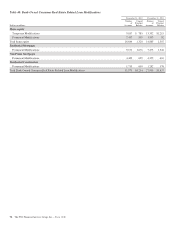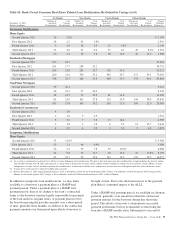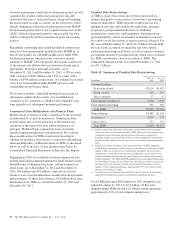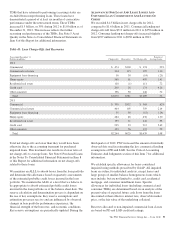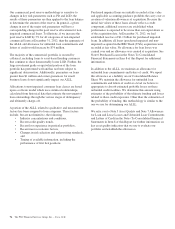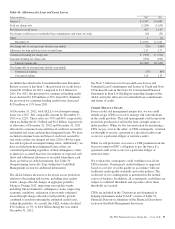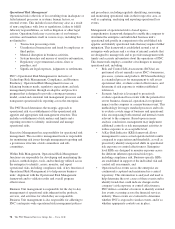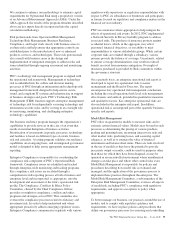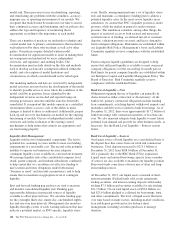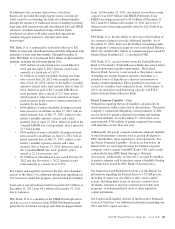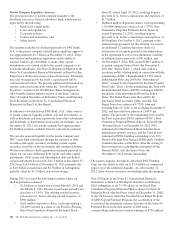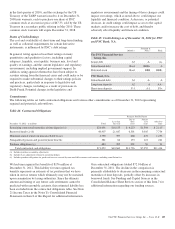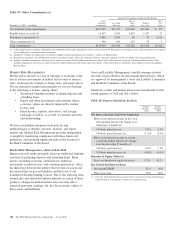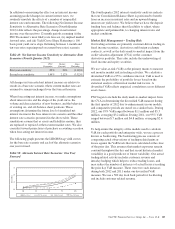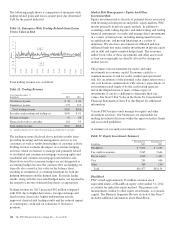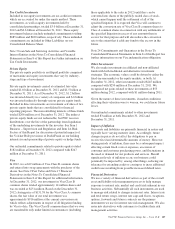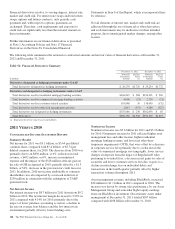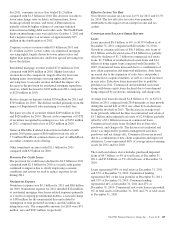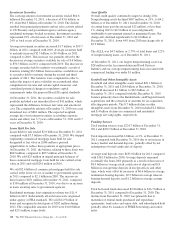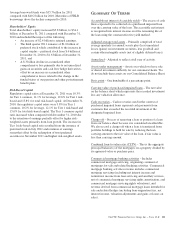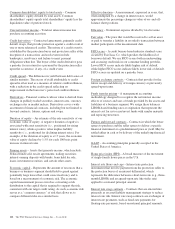PNC Bank 2012 Annual Report Download - page 121
Download and view the complete annual report
Please find page 121 of the 2012 PNC Bank annual report below. You can navigate through the pages in the report by either clicking on the pages listed below, or by using the keyword search tool below to find specific information within the annual report.Parent Company Liquidity – Sources
The principal source of parent company liquidity is the
dividends it receives from its subsidiary bank, which may be
impacted by the following:
• Bank-level capital needs,
• Laws and regulations,
• Corporate policies,
• Contractual restrictions, and
• Other factors.
The amount available for dividend payments by PNC Bank,
N.A. to the parent company without prior regulatory approval
was approximately $1.5 billion at December 31, 2012. There
are statutory and regulatory limitations on the ability of
national banks to pay dividends or make other capital
distributions or to extend credit to the parent company or its
non-bank subsidiaries. See Note 22 Regulatory Matters in the
Notes To Consolidated Financial Statements in Item 8 of this
Report for a further discussion of these limitations. Dividends
may also be impacted by the bank’s capital needs and by
contractual restrictions. We provide additional information on
certain contractual restrictions under the “Trust Preferred
Securities” section of the Off-Balance Sheet Arrangements
And Variable Interest Entities section of this Item 7 and in
Note 14 Capital Securities of Subsidiary Trusts and Perpetual
Trust Securities in the Notes To Consolidated Financial
Statements in Item 8 of this Report.
In addition to dividends from PNC Bank, N.A., other sources
of parent company liquidity include cash and investments, as
well as dividends and loan repayments from other subsidiaries
and dividends or distributions from equity investments. As of
December 31, 2012, the parent company had approximately
$3.4 billion in funds available from its cash and investments.
We can also generate liquidity for the parent company and
PNC’s non-bank subsidiaries through the issuance of debt
securities and equity securities, including certain capital
securities, in public or private markets and commercial paper.
We have an effective shelf registration statement pursuant to
which we can issue additional debt, equity and other capital
instruments. Total senior and subordinated debt and hybrid
capital instruments decreased to $11.5 billion at December 31,
2012 from $16.0 billion at December 31, 2011 primarily due
to $4.0 billion in maturities and $2.3 billion in redemptions
partially offset by $1.5 billion in new borrowings.
During 2012 we issued the following securities under our
shelf registration statement:
• $1.0 billion of senior notes issued March 8, 2012 and
due March 8, 2022. Interest is paid semi-annually at a
fixed rate of 3.30%. The offering resulted in gross
proceeds to us, before offering related expenses, of
$990 million,
• Sixty million depositary shares, each representing a
1/4,000th interest in a share of our Fixed-to-Floating
Rate Non-Cumulative Perpetual Preferred Stock,
Series P, issued April 24, 2012, resulting in gross
proceeds to us, before commissions and expenses, of
$1.5 billion,
• Eighteen million depositary shares, each representing
a 1/4,000th interest in a share of our 5.375% Non-
Cumulative Perpetual Preferred Stock, Series Q,
issued September 21, 2012, resulting in gross
proceeds to us, before commissions and expenses, of
$450 million. On October 9, 2012, pursuant to the
underwriting agreement for this offering, we issued
an additional 1.2 million depositary shares in
satisfaction of an option granted to the underwriters
in the agreement to cover over-allotments, resulting
in additional gross proceeds of $30 million, and
• On November 9, 2012, PNC issued $500.1 million of
its parent company Senior Notes due November 9,
2022 (the “Senior Notes”), which were sold in a
secondary public offering made in connection with the
remarketing of PNC’s Remarketable 8.729% Junior
Subordinated Notes due 2043 (the “Subordinated
Notes”) owned by the National City Preferred Capital
Trust I (the “Trust”). In the remarketing, the Trust sold
the Subordinated Notes and PNC exchanged with the
purchasers of the Subordinated Notes the Senior
Notes. The Senior Notes were then sold by the
purchasers in the secondary public offering. The
Senior Notes bore interest at 8.729% from and
including June 10, 2012, to but excluding November 9,
2012, and thereafter bear interest at 2.854% per
annum. The proceeds of the remarketing were used by
the Trust to purchase $500.1 million of PNC’s Non-
Cumulative Perpetual Preferred Stock, Series M (the
“Preferred Stock”) on December 10, 2012. PNC
redeemed all of the Preferred Stock from the Trust
immediately upon its issuance, and the Trust in turn
redeemed all $500.0 million outstanding of its 12%
Fixed-to-Floating Rate Normal APEX and $.1 million
Common Securities of the Trust. After the closing of
these transactions, including the redemption of the
Normal APEX, only the Senior Notes due
November 9, 2022 remain outstanding.
The parent company, through its subsidiary PNC Funding
Corp, has the ability to offer up to $3.0 billion of commercial
paper to provide additional liquidity. As of December 31,
2012, there were no issuances outstanding under this program.
Note 19 Equity in the Notes To Consolidated Financial
Statements in Item 8 of this Report describes our February
2010 redemption of all 75,792 shares of our Fixed Rate
Cumulative Perpetual Preferred Shares, Series N (Series N
Preferred Stock) that had been issued on December 31, 2008
to the US Treasury under the Troubled Asset Relief Program
(TARP) Capital Purchase Program, the acceleration of the
accretion of the remaining issuance discount on the Series N
Preferred Stock in the first quarter of 2010 (and a
corresponding reduction in retained earnings of $250 million
102 The PNC Financial Services Group, Inc. – Form 10-K


